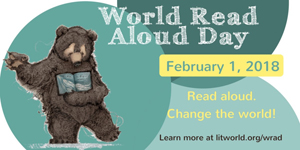 Before I began reading on my own, my mother’s voice brought the letters and colorful characters of my picture books to life. Her voice, combined with the authors’ journeys, created within me a sense of well-being as well as the belief that I could be and do many things in the world. Many years later, that feeling has turned me into a lifelong reader, and has inspired me to create LitWorld to make sure every child gets to experience the joy that reading brings to a person’s soul and spirit.
Before I began reading on my own, my mother’s voice brought the letters and colorful characters of my picture books to life. Her voice, combined with the authors’ journeys, created within me a sense of well-being as well as the belief that I could be and do many things in the world. Many years later, that feeling has turned me into a lifelong reader, and has inspired me to create LitWorld to make sure every child gets to experience the joy that reading brings to a person’s soul and spirit.
Literacy is an act of power and freedom. It is why slaves in our wrenching and painful U.S. history were forbidden to learn to read and write, and why young girls living in repressive societies today are kept out of the classroom. When children realize the power of narrative, they begin to dismantle patriarchy, racism, and oppression. In a true democratic society, every child has these tools of literacy to both absorb the stories of the world and to tell his or her own.
The most effective way to cultivate a love of reading in children is to read to them. A study conducted by the Melbourne Institute of Applied Economic and Social Research found that reading aloud to children every day puts them almost a year ahead (academically) of children who do not receive daily read-aloud. This practice sets the stage for lifelong success.
LitWorld’s World Read Aloud Day (WRAD) was inspired by a conversation with a young student. I was reading a book aloud to him and his classmates when he looked at me and said, “Mrs. Allyn, let’s make sure everyone knows how good this feels. Let’s have a holiday for the read-aloud.” I realized that sometimes in education we have this idea that if something is fun for children, it must not good for them. But here, we have a purely simple case; the read-aloud, yes, is fun for children, but also deeply good for them (and for democracy).
There’s much more to reading aloud than reciting words from a page. It’s a meaningful experience for your students (at all ages), and fine-tuning it is key to fostering a passion for stories, language, and social justice in everyone.
Here are five ways to create a home or classroom environment for more impactful read-aloud:
- Designate a special place and time for reading aloud: Whether it’s creating an elaborate fort together or something simpler, like a reading “nook,” building a safe space allows kids to relax and open up for conversation and to engage around the books you are reading together.
- Keep track of books that inspire the richest conversations: Make a file on your device to save favorite read-aloud titles. Find space in your classroom to post children’s reviews and comments after reading. Document the journey together, valuing the titles that invite new worlds and/or reflect your deepest selves.
- Solicit your students for story recommendations and books they want to read (and read again) to share ownership of the read aloud experience: Scholastic, our extraordinary sponsor in WRAD, published the Kids and Family Reading Report, which shows that children are most likely to finish (and enjoy) books they choose themselves.
- Make read-aloud a performance: Invite students from other classrooms, teachers, librarians, staff, parents, grandparents and members of the local community. Stage a play, read aloud from children’s own narratives, or host a read-aloud-athon on World Read Aloud Day to bring the importance of reading aloud to the fore.
- Use read-aloud as a tool for social justice and equity: By discussing a shared text, we can honor and hear quieter voices in our classrooms and at home. Make sure to stop for “turn and talks” during the read-aloud and to select books that reflect a wide range of cultures, languages, and perspectives.
In this way, multiple voices and stories wash over your community like a cleansing, celebratory rain, signifying the start of a new era and a time when all children’s voices matter and will be heard.
Join us on February 1 (and the other 364 days of the year!) to see reading and literacy transform children’s lives. Visit us at litworld.org/wrad to find related resources and our Facebook page to see (and post) photos from across the world in the coming days and weeks. Remember to use the tag #WorldReadAloudDay to share your experiences!
 Pam Allyn is the founding director of LitWorld, a global literacy initiative serving children across the United States and in more than 60 countries, and LitLife, a cutting-edge consulting group working with schools to enrich best practice teaching methods and building curriculum for reading and writing.
Pam Allyn is the founding director of LitWorld, a global literacy initiative serving children across the United States and in more than 60 countries, and LitLife, a cutting-edge consulting group working with schools to enrich best practice teaching methods and building curriculum for reading and writing.